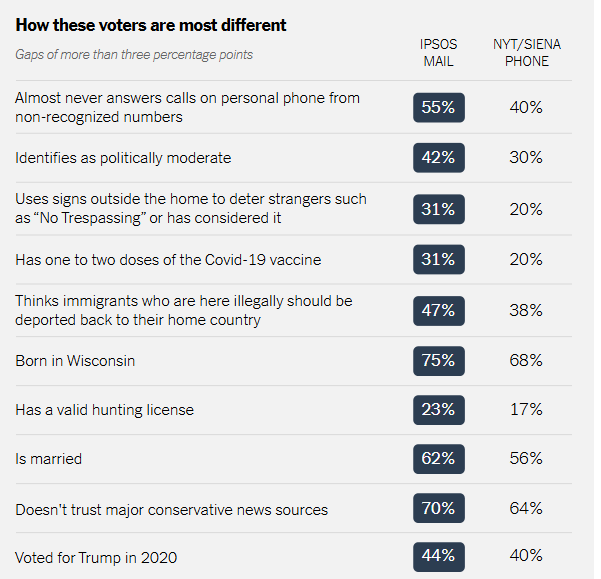Today’s post is going to be a quick look at the results of a high-incentive mail survey the New York Times ran in Wisconsin in late 2022. I’m not going to be revealing anything that isn’t already mentioned in Nate Cohn’s article on the topic, but I continue to think this survey is one of the most interesting pieces of political analysis in the last several years and did not get enough attention at the time.
I’ve mentioned this survey previously in a post about how Harris probably won elderly voters, but essentially they paid respondents $25 to take the survey, and in doing so managed to get a 30% response rate, around 20x higher than a regular phone-based NYT/Siena poll that was done concurrently.
The most important takeaway vis-à-vis the impending 2022 midterm elections was that there was no significant hidden Republican vote like there was during peak COVID in 2020; for Senate/Governor the paid mail survey was just 1-2% to the right of the telephone poll, well within the bounds you’d expect through random chance. But to me the much more interesting thing, which was talked about in the NYT article but I’d loved to have seen a deeper dive on, is that the mail survey really did tap into a ‘silent majority’ that isn’t captured by telephone polls, it’s just not a Republican silent majority. It’s the moderate majority, the incoherent majority, the distrustful majority.
What this data shows is that the average American is significantly more distrustful of strangers than the small share of Americans who normally answer phone surveys. Our silent majority likes to keep people off their property uninvited and is suspicious of phone calls they don’t recognize. They’re also more stereotypically conservative in many ways — they are likelier to be conservative on immigration, to hunt, to be married and to live in their state of birth. This is probably linked to higher Trump support: recalled vote in the phone poll was Biden+5 vs a tie in the mail survey, the actual WI result was Biden +1. Yet at the same time the silent majority is less trusting of major conservative news sources like Fox News. Furthermore, the share who identify as ‘moderate’ is far higher than in telephone poll respondents (42% vs 30%), suggesting that the ‘conservative’ share is much lower, as well as the ‘liberal’ share.
It’s tempting to think of these results as paradoxical, but I don’t think of it that way. The silent majority can most easily be typified as disinterested and distrustful, and while that can manifest in conservative views (anti-illegal immigration), it can just as easily manifest as distrust of conservatism as a movement. These are not true believers in MAGA or the Republican Party, but hesitant allies who have leaned Trump in the last decade simply because what he’s selling is a bit more palatable than the Democratic alternative.
To me, the most important takeaway from all this is that the heterodox—some call it the incoherent—middle in US politics, is really big. It’s bigger than most regular polls will ever show. And that means that either party can do really well by appealing more to this group, a group made up almost entirely of people with some left-wing opinions and some right-wing opinions. Understanding how they feel about the different issues, and learning how to cater to them, is essentially the entire ballgame of winning US elections. Democrats can do it, they just have to want to.




